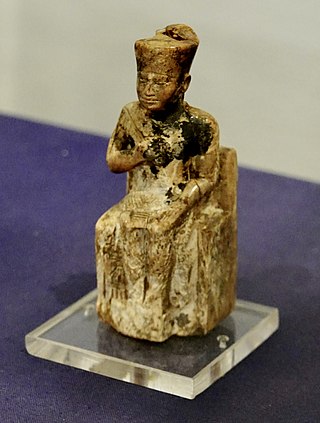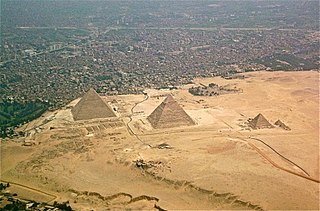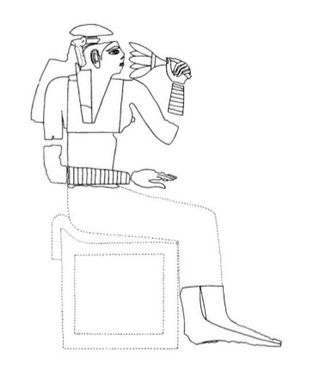
The Great Pyramid of Giza is the largest Egyptian pyramid. It served as the tomb of pharaoh Khufu, who ruled during the Fourth Dynasty of the Old Kingdom. Built c. 2600 BC, over a period of about 26 years, the pyramid is the oldest of the Seven Wonders of the Ancient World, and the only wonder that has remained largely intact. It is the most famous monument of the Giza pyramid complex, which is part of the UNESCO World Heritage Site "Memphis and its Necropolis". It is situated at the northeastern end of the line of the three main pyramids at Giza.

Giza is the third-largest city in Egypt by area after Cairo and Alexandria; and fourth-largest city in Africa by population after Kinshasa, Lagos, and Cairo. It is the capital of Giza Governorate with a total population of 4,872,448 in the 2017 census. It is located on the west bank of the Nile opposite central Cairo, and is a part of the Greater Cairo metropolis. Giza lies less than 30 km (18.64 mi) north of Memphis, which was the capital city of the unified Egyptian state during the reign of pharaoh Narmer, roughly 3100 BC.

Khufu or Cheops was an ancient Egyptian monarch who was the second pharaoh of the Fourth Dynasty, in the first half of the Old Kingdom period. Khufu succeeded his father Sneferu as king. He is generally accepted as having commissioned the Great Pyramid of Giza, one of the Seven Wonders of the Ancient World, but many other aspects of his reign are poorly documented.

The Egyptian pyramids are ancient masonry structures located in Egypt. Sources cite at least 118 identified "Egyptian" pyramids. Approximately 80 pyramids were built within the Kingdom of Kush, now located in the modern country of Sudan. Of those located in modern Egypt, most were built as tombs for the country's pharaohs and their consorts during the Old and Middle Kingdom periods.

The pyramid of Menkaure is the smallest of the three main pyramids of the Giza pyramid complex, located on the Giza Plateau in the southwestern outskirts of Cairo, Egypt. It is thought to have been built to serve as the tomb of the Fourth Dynasty Pharaoh Menkaure.

The Giza pyramid complex in Egypt is home to the Great Pyramid, the Pyramid of Khafre, and the Pyramid of Menkaure, along with their associated pyramid complexes and the Great Sphinx. All were built during the Fourth Dynasty of the Old Kingdom of ancient Egypt, between c. 2600 – c. 2500 BC. The site also includes several temples, cemeteries, and the remains of a workers' village.

Mark Lehner is an American archaeologist with more than 30 years of experience excavating in Egypt. He is the director of Ancient Egypt Research Associates (AERA) and has appeared in numerous television documentaries.

The Giza Plateau is a limestone plateau in Giza, Egypt, the site of the Fourth Dynasty Giza pyramid complex, which includes the pyramids of Khufu, Khafre and Menkaure, the Great Sphinx, several cemeteries, a workers' village and an industrial complex. It forms the northernmost part of the 16,000 ha Pyramid Fields in the Western Desert edge of the Nile Valley that are part of the UNESCO World Heritage Site, Memphis and its Necropolis.

The Khufu ship is an intact full-size solar barque from ancient Egypt. It was sealed into a pit alongside the Great Pyramid of pharaoh Khufu around 2500 BC, during the Fourth Dynasty of the ancient Egyptian Old Kingdom. Like other buried Ancient Egyptian ships, it was part of the extensive grave goods intended for use in the afterlife. The Khufu ship is one of the oldest, largest, best preserved vessels from antiquity. It is 43.4 metres (142 ft) long, 5.9 metres (19 ft) wide, and 1.78 meters deep, and is the world's oldest intact ship. It has been described as "a masterpiece of woodcraft" that could sail today if put into a lake or a river.

Hetepheres I was a queen of Egypt during the Fourth Dynasty of Egypt who was a wife of one king, the mother of the next king, the grandmother of two more kings, and the figure who tied together two dynasties.
Meritites I was an ancient Egyptian queen of the 4th Dynasty. Her name means "Beloved of her Father". Several of her titles are known from a stela found at Giza. She was buried in the middle Queen’s Pyramid in Giza.

Henutsen is the name of an ancient Egyptian queen consort who lived during the 4th dynasty of the Old Kingdom Period. She was the second or third wife of pharaoh Khufu and most possibly buried at Giza.

The East Field is located to the east of the Great Pyramid of Giza and contains cemetery G 7000. This cemetery was a burial place for some of the family members of Khufu. The cemetery also includes mastabas from tenants and priests of the pyramids dated to the 5th and 6th Dynasty.

G1-a is one of the subsidiary pyramids of the Giza East Field of the Giza Necropolis, located immediately to the eastern side of the Great Pyramid of Giza. It was built during the Fourth Dynasty of Egypt. The tomb is the northernmost of the three pyramids of the queens.

G1-c is one of the subsidiary pyramids of the Giza East Field of the Giza Necropolis immediately to the eastern side of the Great Pyramid of Giza, built during the Fourth Dynasty of Egypt. It is the southern of the three pyramids of the queens and is the one of Queen Henutsen. It is 46.25 metres wide and had a height of 29.6 metres. A niche, four inches deep was dug in the south wall of the burial chamber. Pyramid G1-c was originally not a part of Khufu's pyramid complex, as its southern side is aligned not with the side of the Great Pyramid, but with Khufukhaf I's mastaba tomb nearby. Pyramid G1-c was at some point thought to possibly be a satellite pyramid, because it did not come with a boat pit like pyramids G1-a and G1-b. It was later determined to be an unfinished pyramid which was constructed in a hurry. Henutsen is thought to have been buried in the tomb. Dr. Rainer Stadelmann believes Khufukhaf is the same person as Khafra and the pyramid was built by him for his mother, but this identification is doubtful.

Pyramid G1-d is a satellite pyramid within the Khufu pyramid complex on the Giza plateau.

The Giza Solar boat museum was dedicated to display the reconstructed Khufu ship, a solar barque of pharaoh Khufu. It was constructed between 1961 and 1982, just a few meters from where the Khufu ship was found, on the southern side of the Great Pyramid, on the Giza Plateau in Egypt

The Inventory Stela is an ancient Egyptian commemorative tablet dating to the 26th Dynasty. It was found in Giza during the 19th century. The stela presents a list of 22 divine statues owned by a Temple of Isis, and goes on to claim that the temple existed since before the time of Khufu.

In Egypt, the Western Desert is an area of the Sahara that lies west of the river Nile, up to the Libyan border, and south from the Mediterranean Sea to the border with Sudan. It is named in contrast to the Eastern Desert which extends east from the Nile to the Red Sea. The Western Desert is mostly rocky desert, though an area of sandy desert, known as the Great Sand Sea, lies to the west against the Libyan border. The desert covers an area of 680,650 km2 (262,800 sq mi) which is two-thirds of the land area of the country. Its highest elevation is 1,000 m (3,300 ft) in the Gilf Kebir plateau to the far south-west of the country, on the Egypt-Sudan-Libya border. The Western Desert is barren and uninhabited save for a chain of oases which extend in an arc from Siwa, in the north-west, to Kharga in the south. It has been the scene of conflict in modern times, particularly during the Second World War.

G3-b is one of the three pyramid companions Pyramid of Menkaure. It is located on the south side of the Menkaure pyramid in the Giza Necropolis. It is the middle of the three pyramids of the queens, and in the structure the body of a woman was discovered. The American archaeologist George Andrew Reisner speculated that the queen buried in the pyramid may have been Menkaure's half-sister, Shepsetkau, the daughter of Meresankh III and Khafre.




















